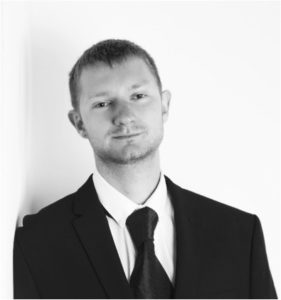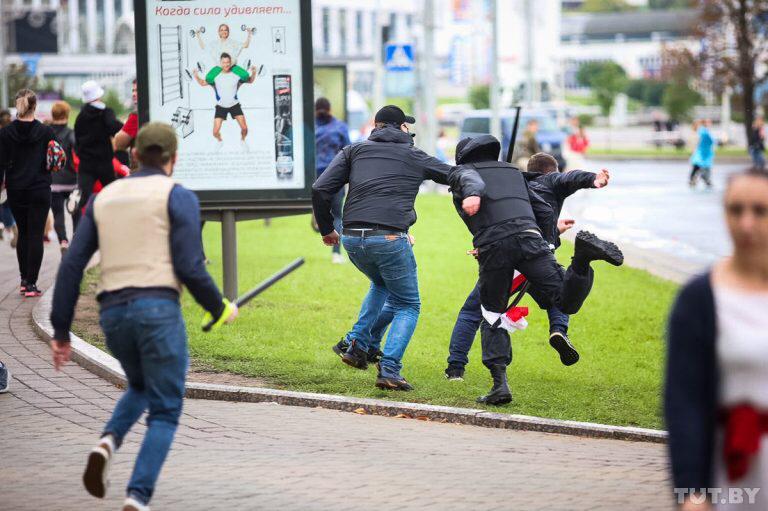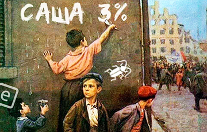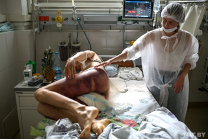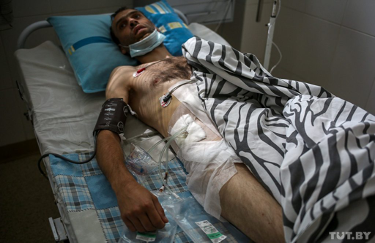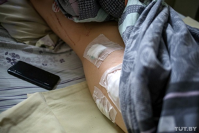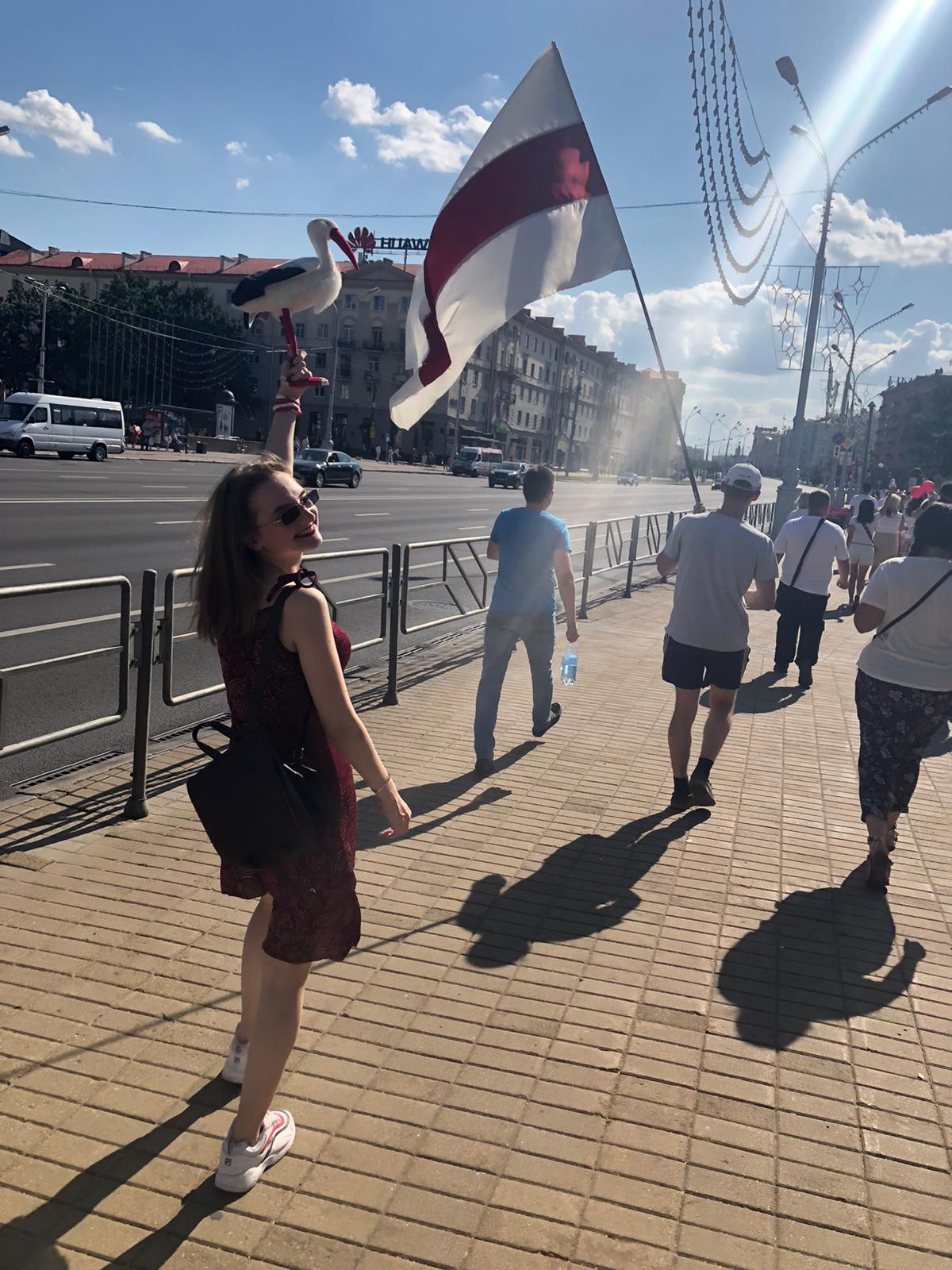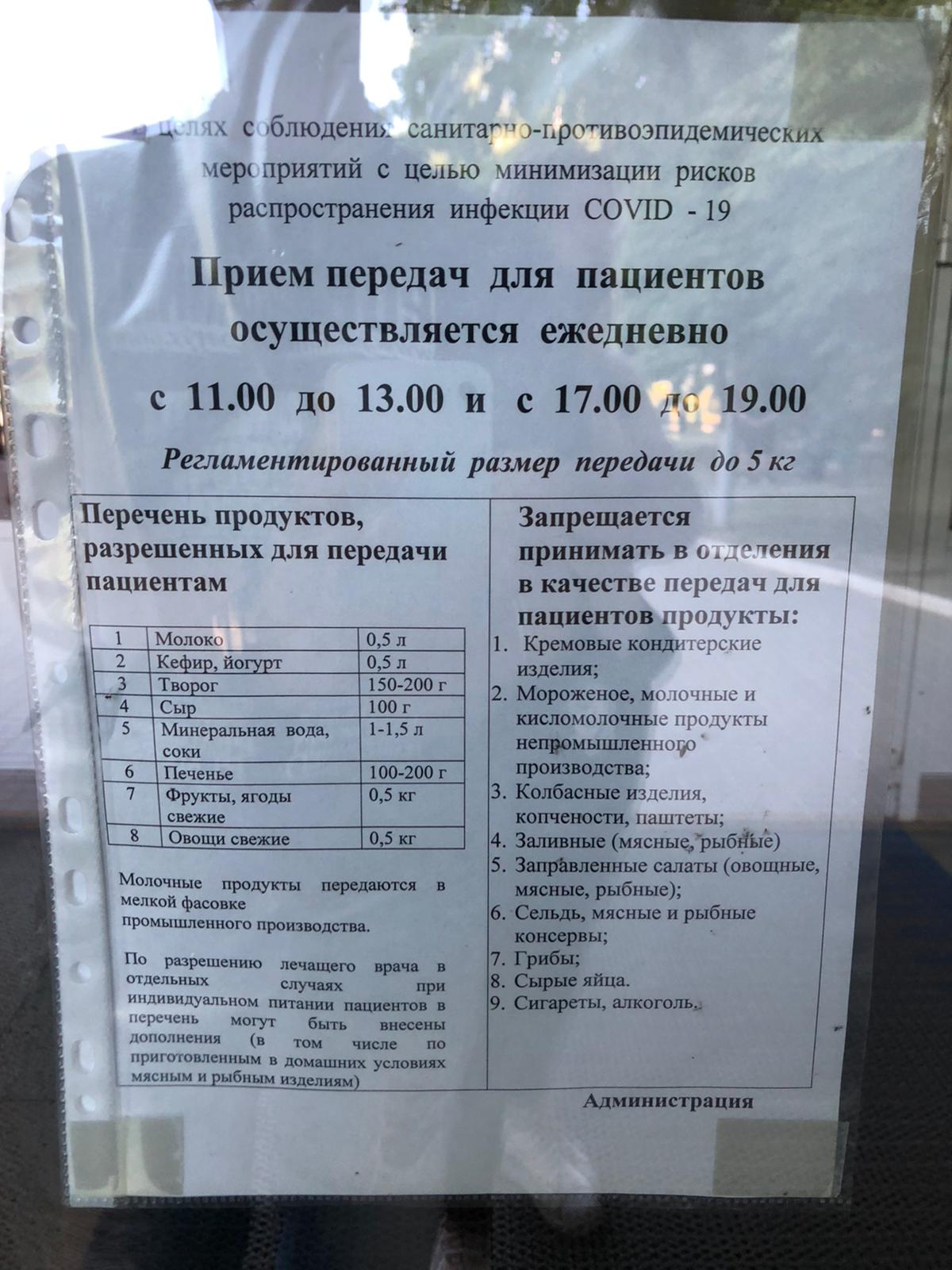In Belarus since the last elections, Nikita reports daily for the CREER, giving us some valuable information and personal impression on what’s going on in his birth country.
Multi-skilled professional analyst with several areas of expertise, such as international relations, regional analysis of European affairs and research on Eastern Europe, Nikita is writing for the CREER since 2017. His work had also been published in Le Monde Diplomatique in 2019.
https://www.youtube.com/watch?v=QAvwodpTWnE
Sunday , at least 100000 people rallied in Minsk, September the 6th, to demand the resignation of Alexander Lukashenko, as Belarus has entered the fourth week of daily protests since the presidential election on the 9th of August, results of which were widely seen as rigged, and described by the EU, the US and the rest of the democratic world as “neither free nor fair”.
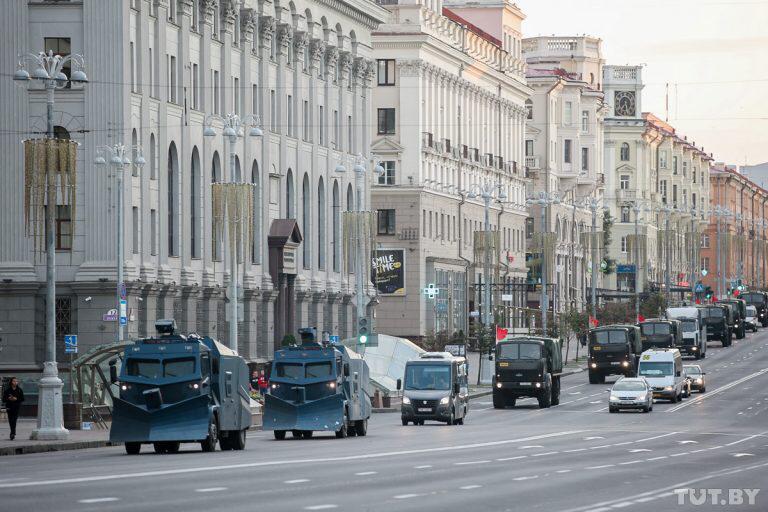
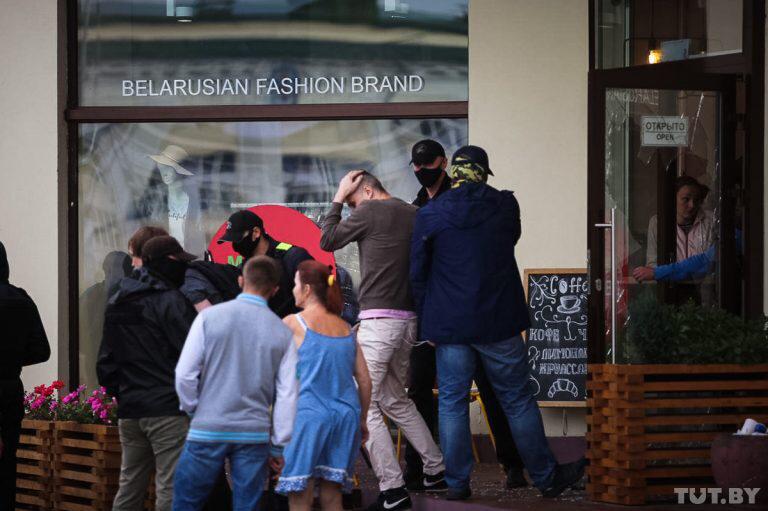
In the absence of any provocations on the protesters’ side, militia in civilian clothes with black masks are occasionally breaking window glasses to fabricate the illusion of unrest and public disorder only to arbitrary arrest the people around and try to create panic, infuse fear and deteriorate the image of the peaceful protesters and opposition-minded citizens
Thousands of protesters marched to Minsk Hero City Obelisk yesterday for the fourth Sunday in a row. Despite the arrests, beatings, threats and humiliation, Belarusians are far from stopping the fight for justice, Lukashenko’s departure, the release of political prisoners and new fair elections, which were the main points of the exiled Svetlana Tikhanovskaya, regarded as the true president of Belarus according to alternative results of the platforms, such as “Voice” (Голос) and “Bison” (Зубр), amongst others:
https://drive.google.com/file/d/1kSprtBUUtS1vb-W_jc4QJkPkoZPJBWxd/view?usp=drivesdk
https://42.tut.by/697429
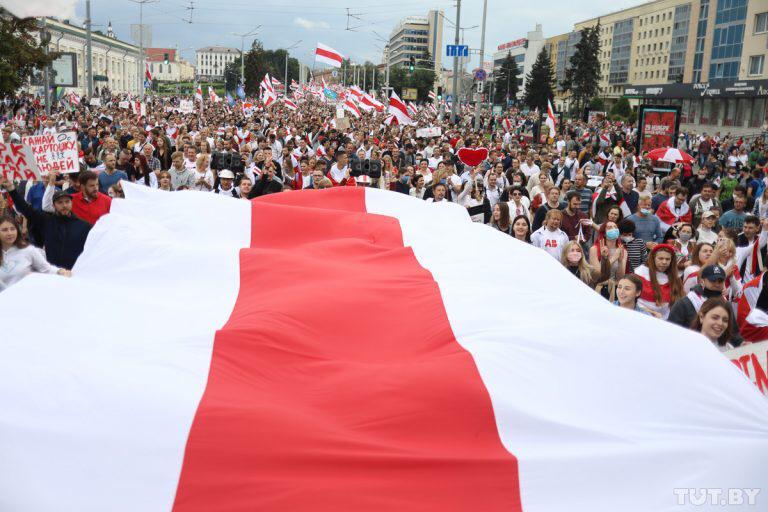
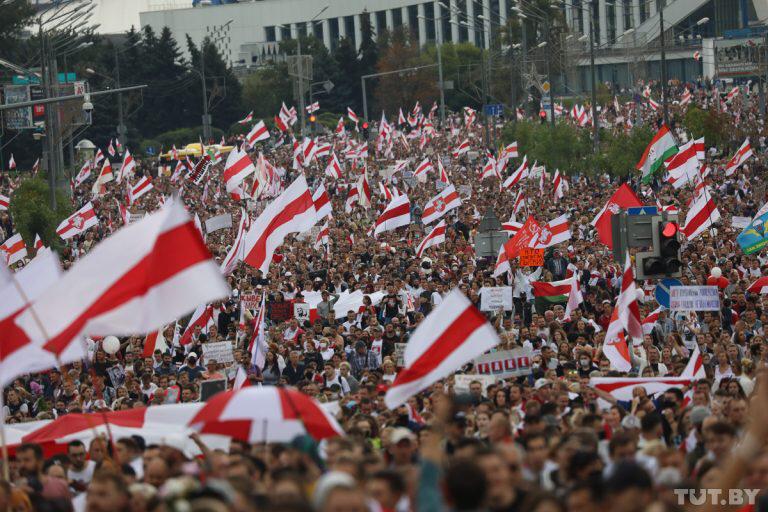

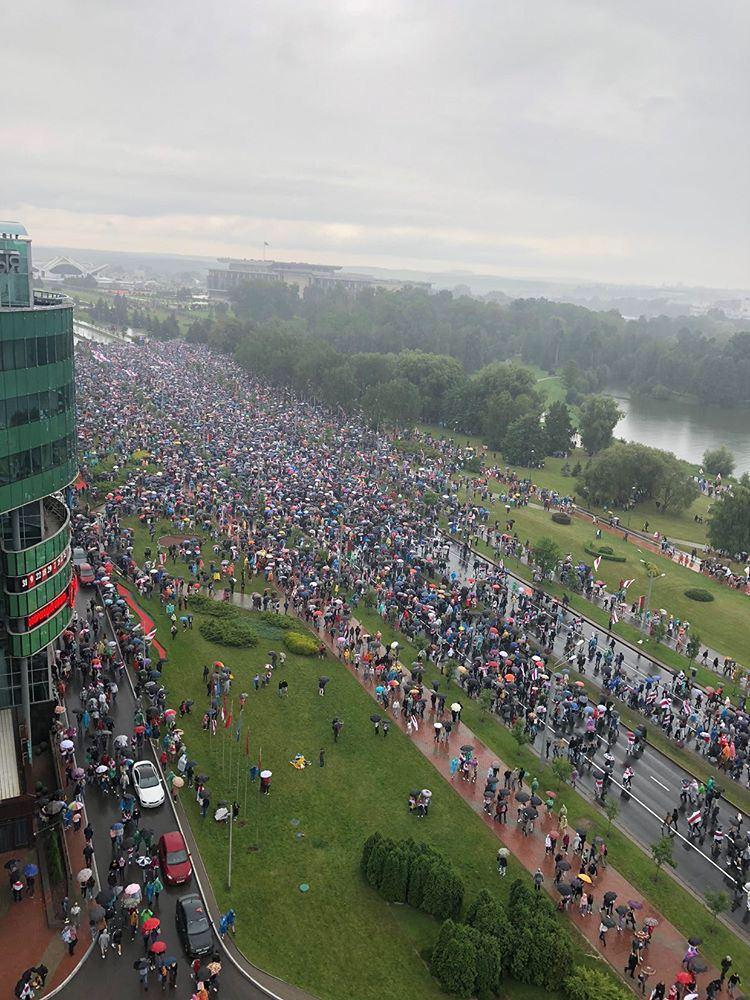

Minsk, August 28
Les protestations prennent de plus en plus une dimension culturelle. Un peu partout dans les centres commerciaux de Minsk, les chants résonnent.
Les artistes se rassemblent autour du théâtre Ianki Koupali (Янки Купалы) chaque jour de 12 à 14h30. Parmi eux, nombreux sont ceux ayant démissionné ou ont été renvoyés. Ils continuent ainsi à faire de petites performances.
Dans le même temps, le rouble biélorusse est en train de chuter. Le taux de change évolue chaque jour et il devient presque impossible d’acheter des dollars en ce moment. L’Euro étant quasiment impossible à trouver, l’on commence à acheter les Zloty polonais ou les couronnes tchèques, parfois les roubles russes.
Les prix à la consommation ont commencé à grimper et on attend le pire en septembre, c’est à dire, dans quelques jours. Les estimations portent le dollar de 2,5 (il y une semaine) à 3 roubles dans quelques jours et l’Euro de 2,8 à 3,5 roubles.

Minsk, August 19
The article below is a translation, by Yana Berzina, from the original article published on the serious and reliable media News.tu.by https://news.tut.by/society/697133.html?tg
“Who’s against the honest results? The Executive Committee.” After the election, the precinct commission was deciding which results to make public — video
TUT.BY received a video that revealed what was happening behind closed doors on Election Day at the 44th and 43rd precincts which were located at the 203rd Secondary School. While voters waited outside until midnight for the results to come in, the two precinct commissions were casting their own votes as to which protocol to show the people.
“Everybody, calm down!” a male voice says in the video. “We’ll figure something out.”
“And then what? What will happen to us tomorrow? Have you thought about that?” one woman asks emotionally.
“So let’s post the protocol.”
“Let in the representatives, ours is ready.”
[…]
“So go ahead, make your choice,” a female voice says, addressing the chairmen and chairwomen of both commissions. “There are people standing behind you. […] Yeah, what did you think? We’re not like them?”
“In all seriousness though, have you looked outside the window? It’s no joke,” another voice comments from behind the camera, seemingly referencing the crowd of voters that gathered outside the building to wait for the election results.
“And it’s here, in a neighborhood where they don’t know us. It’s not even our neighborhood. And there’s also our neighborhood out there somewhere.”
“I’m the one who’s going to live here,” says another member of the commission.
“So let’s all vote then, if we have so many different opinions.”
“Yeah, it seems we’ve had more opinions than we did voters,” somebody notes.
“It’s alright, we know how to count.”
[…]
“We have two protocols too,” a member of the second commission speaks up. “But they’re not going to let us walk out with the actual protocols,” he says, addressing both commissions.
“You want to live in fear? For what? We have kids, we have grandchildren.”
[…]
“I want to walk out that door the same way I came in today. I don’t want to be hiding behind every bush I see for the next year.”
“They know where we live, all of us,” adds someone else.
[…]
“Tell us please, what’s your solution?”
“Here we show them the real votes. And then, we hand over to the Executive Committee what they asked for. We’re all human, we all have families. These people want their votes, the authorities want theirs.
“And we all know what the real position is.”
“And that’s why we came to you. Let’s show these people the votes that they want.”
“And let the authorities decide what to do with that.”
“The authorities can’t guarantee us protection. This is real.”
“Exactly. They sent us what, five officers from Special Forces? And then what? Five officers are supposed to safeguard the group of 35 people?”
“So what do we decide?” a woman interrupts.
“To announce the honest results. Right?”
“We should at least try.”
Then the two commissions vote on which protocol to make public.
“The question is, who’s against the honest results?”
“The Executive Committee,” someone says.
In the end, one person abstained while everybody else voted in favor of posting the honest protocol.
The commission was shocked, they said, “How are we supposed to post such a fraudulent protocol?”
On condition of anonymity one member of the electoral commission of the 44th precinct agreed to speak to TUT.BY. It wasn’t his first time counting the votes.
“I honestly hoped this time we’d have an honest presidential election. I was ready for it to be rigged just like last time, but I have never seen such flagrant violation of the Electoral Code before.”
According to the chairman, the protocol they would post during the early voting period was factually correct and reflected the real voter turnout from August 4 to August 8, which was 150 people in total.
“But by the morning of August 9 those 150 people suddenly turned into 758 people! Just so you understand: we have the total of 1878 people registered to vote at our precinct.”
He showed TUT.BY the final results—the protocol they ended up posting on the door by midnight of August 9: Svetlana Tsikhanovskaya had 597 votes, Aleksandr Lukashenko had 292 votes, Anna Kanopatskaya had 54 votes, Sergey Cherchen had 37 votes, and Andrey Dmitriyev had 33 votes.
“Once we’d counted the votes, we still had to falsify the numbers. Having taken into account the fabricated colossal turnout during the early voting, we would have had a statistically impossible total turnout at around 130-150%,” he explained. “The only thing true about the protocol we put up was that Tsikhanovskaya had won. When we opened the ballot box for the early voting, 99% of the vote was for Lukashenko. With ballots for the main day of the election, it was almost the opposite. Lukashenko had 10% at best. Tsikhanovskaya had 85%. Other candidates had minor support.”
According to the chairman, the initial protocol they were supposed to go with read completely different numbers: 80% for Lukashenko, 10% for Tsikhanovskaya.
“The commission was shocked, they said, “How are we supposed to post such a fraudulent protocol?” And, in order to have the other commission from the 43rd precinct on our side and, most importantly, not to throw them under the bus, we’ve decided to vote on what to do, both of the commissions. And we voted to announce the real winner, Tsikhanovskaya,” he said.
The commission then demanded that the initial protocol be destroyed.
Traditionally the police would take shifts to guard the precincts on Election Day, but this year was the first time that OMON [the riot police in Belarus] showed up. The member of the commission explained why this happened:
“At first there were three police officers. When the crowd outside started to grow once the precinct had closed, two more officers arrived, both armed with machine guns and special equipment. Then five members of OMON showed up and told us they were only evacuating the chairmen, secretaries, ballots and other records. They told us to keep our heads up and to wait for a bigger OMON squad to come. When we posted the protocol that announced Tsikhanovskaya as a winner, the crowd was chanting “thank you,” so we were able to leave the building no problem.”
TUT.BY reached out to the administration of the Pervomaisky District for comment but were redirected to the territorial commission. They were later told that the territorial commission ceased to exist as of last week and were advised to contact a different commission, this time Minsk city commission.
When they called Minsk city commission, on the other end of the line they heard, “There’s no one left here, just an empty office.”
Minsk, 19 August
By Nikita Taranko Acosta
It is the 11th day of peaceful demonstrations and the 8th day of protest strikes after the election unrest spread throughout the whole country.

The situation has become almost catastrophic and the outcome is still unclear. The demand for change, new, fair elections and the resignation of Alexander Lukashenko is sound and clear, but so are the Government’s stubbornness and unwillingness to surrender or even remotely engage in a meaningful dialogue.
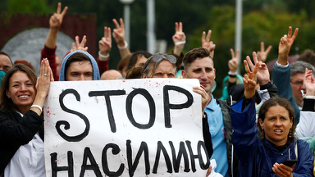
As Ursula Von der Leyen, the president of the European Comission, put it, “The people of Belarus want change and they want it now”. She later added that the elections were, in her view, neither fair nor free and that the EU would support the peaceful transition to democracy in Belarus by not recognising the election results and declaring President Lukashenko as a persona non grata; a decision that has been adopted in the previous days by the European Parliament.
In addition, the EU has agreed to impose a set of sanctions “on a substantial number of individuals responsible for violence, repression and election fraud”, as explained Charles Michel, the European Council President, at the end of an emergency summit of the EU leaders. Financial assistance has also been promised to the tune of 53 million euros, previously intended as aid to go directly to the State and now diverted directly to “victims of repression” as well as independent media and coronavirus recovery. How these funds will eventually reach the targeted populations without being intercepted by the government remains to be seen. On a separate note, in a video statement ahead of Wednesday’s summit, Svetlana Tikhanovskaya called on Europe to support « the awakening of Belarus » explaining that the regime has lost all credibility and that she was now ready to act as a national leader (temporarily) for the sake of the country.
On her initiative, the Coordination Council, a body formed by a group of intellectuals, workers, artists, political and civic activists and other prominent Belarusians figures was formed in order to ensure a peaceful transfer of power. It held its first meeting on 18 August.

Nevertheless, despite these breakthroughs, the resolve of the regime does not seem to fade in the near future. The current Government’s stance cannot be clearer on the matter: The Belarusian opposition is attempting to overthrow the regime with foreign help. Lukashenko’s team is trying to spread this message, as well as other accusations that are broadcasted on the national television. Yuri Karaev, the Interior Minister of Belarus, for example, has recently stated that all protesters that go to the Independence Square in Minsk are paid from abroad, 30 Belarusian roubles for men and 60 for women. Earlier Mr. Lukashenko declared it is unacceptable to put forward women and threaten the families of law enforcement officers, making them look like victims and reversing the role of militia and riot police (commonly perceived as the aggressors). He also pointed out that the republic would never be governed by a government from abroad. Furthermore, to somehow counterattack the peaceful protests, Lukashenko is now beginning to use other means that go beyond spreading his view of the situation through State-controlled media channels or forceful attendance to rallies in his support like the one that took place last Sunday. Appearing somewhat desperate, current strategies include flying helicopters to display the red and green official (anti-opposition) Belarusian State flag all over the country or deploying vehicles without license plates or with closed license plates (which is illegal under Belarusian law) to showcase support for the regime in various places around different cities.
What is more, Mr. Lukashenko has now decided to award medals to over 300 security officials, all employees of the Ministry of Internal Affairs, for what he called “impeccable service”. This was perceived as humiliating for the bulk of Belarusian society that does not support violence and demands the Government assume responsibility and bring all those who participated in the repressions to justice.
As of this dichotomy, neither side is willing to give up. This compromises any immediate solution and jeopardises, in turn, the fragile balance even further making the status quo a stable stalemate for the time being.
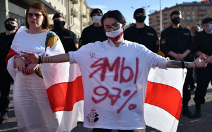
Now, moving aside from the seemingly unending confrontation between the vast majority of Belarusians (97% of the population, according to memes that have flooded the Internet, as well as slogans chanted in the streets against the only 3% of Lukashenko’s supporters) and the remaining loyal figures to the regime and State apparatus, more victims are beginning to give statements and recount the traumatic, excruciating experiences they endured on behalf of the OMON.
“I’ve never felt a pain like this before. And I asked myself: if they go on, will I die or not?”, 20-year-old Alexey Kurachev, who was detained near the Komarovsky market on 13 August told journalists. Alexey has been severely abused, beaten and humiliated in the middle of the street for chanting: “Long live Belarus”. He is currently in intensive care, he cannot get up nor relieve himself, which is why he has a catheter connected to drain urine.
Not less worrying is the story of Maxim Salnikov, a 34-year-old who was also beaten on the street on his way to a store. Going out to buy cigarettes turned out to be all but a walk in the park: hits on the liver for several minutes non-stop, gas sprayed into his eyes, more hits at the Police Department. Maxim had to undergo surgery and was lucky enough to be able to call an ambulance himself once he finally got home.
Maria Zaitseva, a 19-year-old who was unfortunate enough to be visiting Minsk on 9 August, got seriously injured by fragments of a stun grenade and rubber bullets around the Minsk — Hero City Stella monument in the city centre. She has wounds all over her body, especially on the head; her eardrum popped and she temporarily lost her eyesight after the explosion. Doctors are confident, however, that she will recover.
In the following days, more acts of solidarity, strikes and peaceful protests are to be observed. On the other hand, financial support from the EU and the Belarusian diaspora, but also from within the country is expected. In the meantime, the already weakened economy will most likely continue its downfall, which will undoubtedly test the lifespan and the ingenuity of the regime in place.
18 August
A « transitional government » list is circulating on Internet, with a dozen of people under Svetlana Tikhanovskaya’s lead (from Lithuania).
Yesterday more than 10 large Belarusian enterprises went on strike in Minsk and all regional capitals (BelAZ, subway, the Belarusian metallurgy plant, Minsk tractor plant, Naftan, Zhabinka sugar plant etc). This is how they express their protest against the results of the presidential election and the criminal orders of the current regime.
People in all industrial plants were shouting « Go away! » and Alexander Lukashenko was met by striking workers of Minsk Wheeled Heavy Plant (MZKT) and told them « You can never wait for me to do something under pressure, there will be no elections, only after if you kill me »
https://www.theguardian.com/world/2020/aug/17/belarus-opposition-calls-for-general-strike-after-biggest-protests-yet
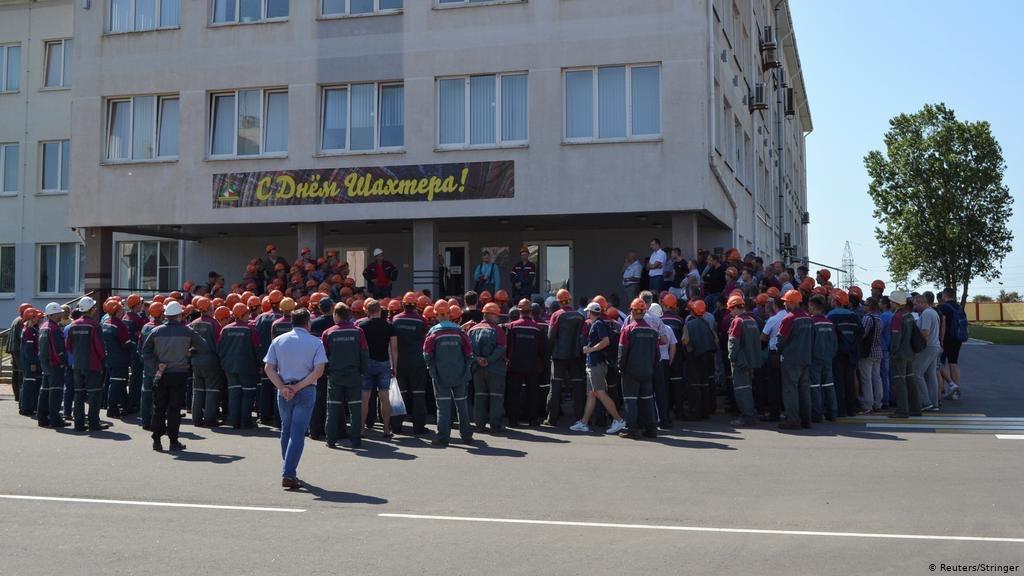
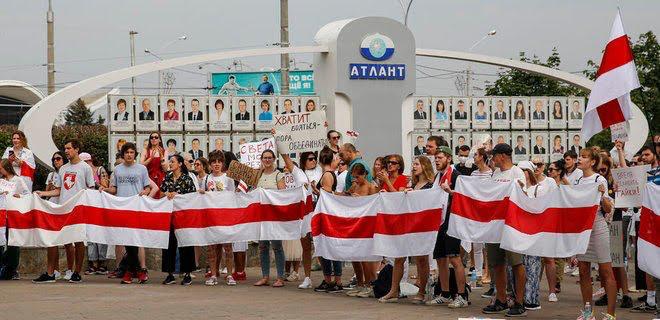
More than 15 companies, plants, factories are on strike from August, 14.
https://infobank.by/infolineview/vtoroj-denj-zabastovok-v-belarusi-kto-bastuet-ili-planiruet/
17 August, Minsk
Avec très peu d’arrestations (quelques dizaines de cas), ce qui a surpris les manifestants, le calme a dominé la manifestation rassemblant des milliers de personnes hier sur l’avenue de l’Indépendance, à Minsk.
Le calme
Hier, dimanche matin, avant la manifestation de masse qui aurait rassemblé entre 300 et 500 000 personnes, de petits rassemblements s’organisent dans le centre ville historique (Nemiga).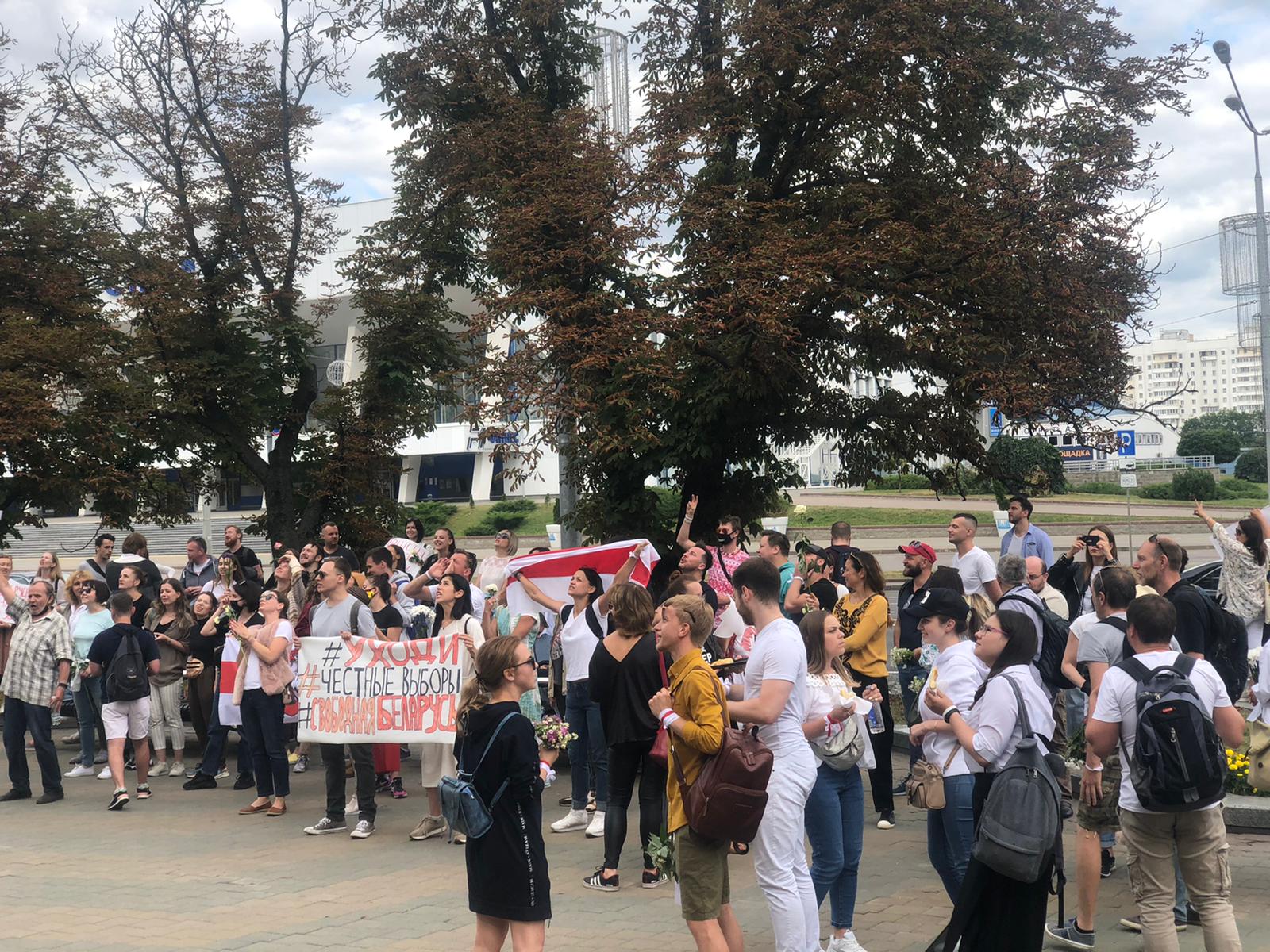
Plus tard, dans l’après-midi, a commencé la marche pacifique sur l’Avenue de l’Indépendance (d’une longueur de 18km, dont les bâtiments, idéalement conservés ou reconstruit dans la période d’après-guerre, candidate pour devenir un site protegé par l’UNESCO ) https://www.google.ch/amp/s/news.tut.by/amp/society/638466.html
Une marche qui s’est déroulée dans le calme. Comme d’habitude, les gens partagent de l’eau, des « «Глазированный сырок»», des ballons et des fleurs.

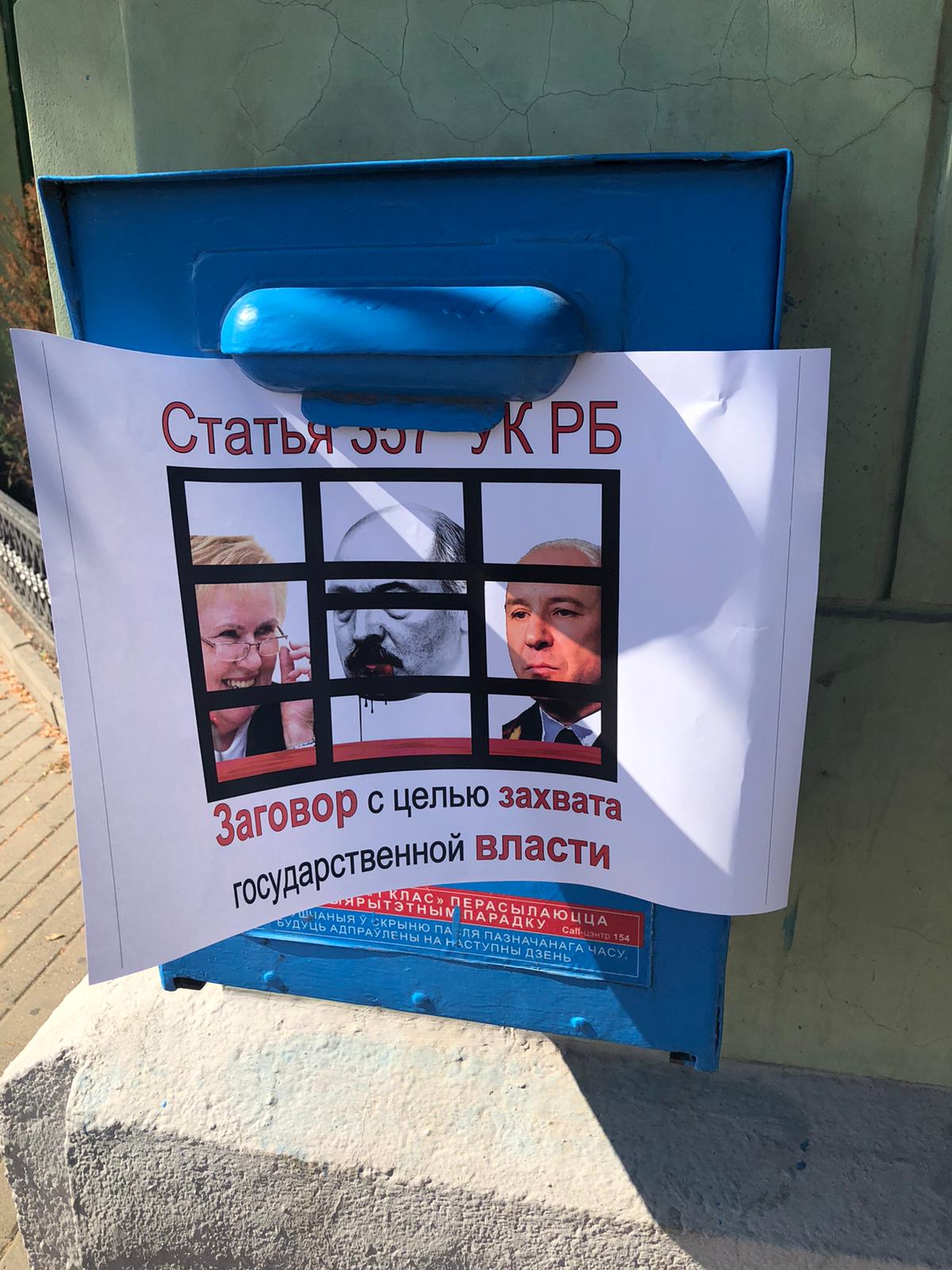

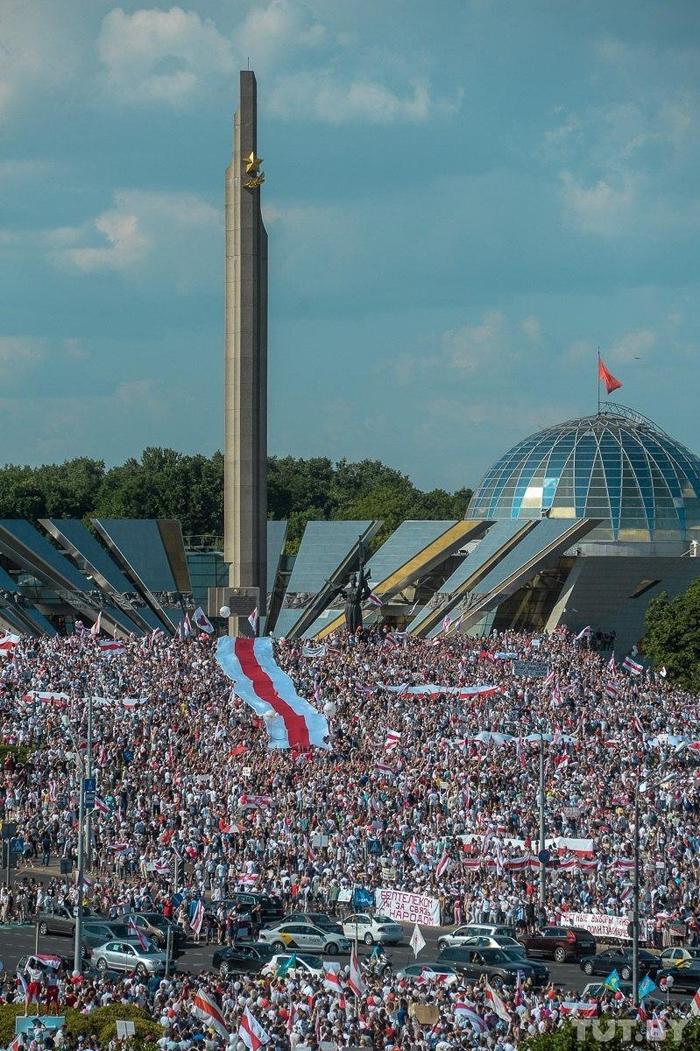
La propreté et le respect du mobilier urbain public

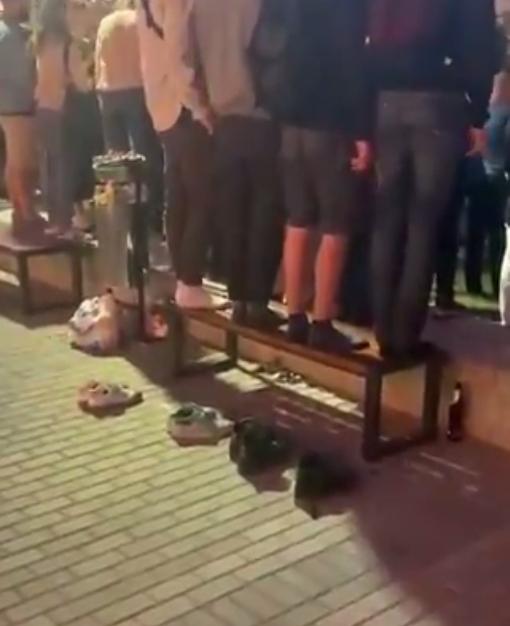
La solidarité dans le pays et à l’extérieur
Alors que les grèves continuent dans presque toutes les usines et grandes entreprises du pays, la diaspora biélorusse a mobilisé une aide sans précédent, avec de très nombreuses donations qui s’organisent en ce moment. Le secteur IT (durement touché) se mobilise également pour venir en aide afin de payer les frais médicaux, les factures, les amendes administratives, l’aide juridique, etc…
Les initiatives locales voient le jour également. Les voitures de particuliers « solidarité » habillées du drapeau rouge et blanc transportent gratuitement les piétons, afin d’éviter les transports publics et les nombreux contrôles qui s’y déroulent.
15 August, Minsk
L’aide s’organise…
Visit to 3 hospitals, where people are lining to give food, water.. to assist the wounded protesters there. Sometimes they don’t let them come in or a specific time schedule is displayed.
Water is provided by the Minskers to the protesters in the streets, squares, etc..
14 August, Minsk
Just as expected, after thousands of women rallied in different Belarusian cities and towns yesterday to protest against the brutal police crackdown that has left hundreds of protesters injured and thousands detained, more people decided to join the peaceful widespread movement. Doctors, builders, teachers, Belarusian railway and metro personnel, workers from the state-run industrial plants, IT companies, as well as thousands of people from varying sectors of the working class flooded the streets of the capital and other cities to show their support for the ongoing peaceful demonstrations to halt violence.
Such gatherings and other spontaneous local solidarity acts kept taking place on Friday throughout the whole country, since early afternoon until late in the night.
On a different note, after a partial release of the detained peaceful protesters in the previous days, shocking images came to public knowledge. Pictures of people kept in custody at Okrestina and Zhodino prisons revealed all the horrors and widespread abuses that occurred behind the scenes: beatings, public humiliation, threats, physical torture, psychological pressure, interrogations, etc.
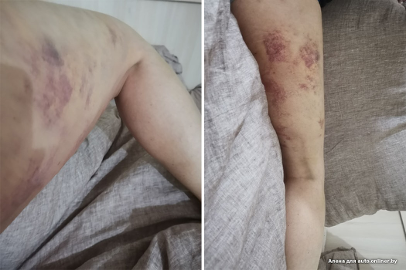
One of the journalists, Alexei Hudanov, who got arrested on the 9th of August, the day of the elections, described his harrowing experience in the following way:
“On the Independence Avenue, we were first thrown into a passenger bus, which stood next to a gas station. Everyone was put on their knees; the bus was gradually filled with people. And then shit started to happen. An OMON [riot police] agent said that our task was to get up, get our things and get out as quickly as possible. So they started beating people up until they got up. One held them, the other beat them up. ‘Go ahead bitch, do you want changes?’, they shouted. Screams, moan… When a man got up, they’d push him out of the bus and take him to a gas station. It felt like a slaughterhouse (…).
When the line came up to me, my legs started to shake. At first, it was a little scary and later it felt quite uncomfortable to sit. Next to me, the dreaded dude said, it’s okay, don’t panic, we’ll make it. He got knocked up with a baton in his mouth – the back of his head was split, blood was quickly being spilled everywhere. I was first hit in the chest and then kicked with the baton on the back, which accidentally caught the buckle, freeing my hands. I got off very well”.
[testimony translated by the author of this article from https://zona.media/article/2020/08/13/zhodino-okrestina].
This is just one case, there are hundreds of examples and versions of the unprecedented agony and distress, very different stories with dissimilar outcomes, but all of them reflect the martyrs’ suffering and are equally frightening. One video went especially viral on the social networks in which a Belarusian girl recounts her brief, but heart-breaking experience: “They beat me hard, 10 people from OMON took off my pants, threatened to fuck me, insulted me, attacked me, further humiliated and threatened me with death before they threw me like an animal to a cell”.
Now, despite these dreadful recounts and the above-mentioned unjustified police brutality, one cannot ignore the popular flash mob that has been on the rise for several days now. Several law enforcement officials are beginning to support the protesters all over Belarus by making public statements and filming themselves as they throw away their uniforms. Some even put the uniforms on fire to make it clear that they will never use them again, others feel ashamed and sorry for what is happening and call their colleagues to cease following criminal orders. This may be not enough to turn the tides yet, but it definitely sets a precedent and may encourage more officers and other government officials to follow the example, just as it has already happened with many famous TV hosts and journalists that resigned from STV, ONT, Belarus 1 and other major Belarusian channels in the past days alleging that they could not broadcast any more lies or present absurd issues that interest no one.
______________________________________________________
Personal view of the author:
So what can be made of all this? Well, we are living in the 21st Century in the middle of Europe. All the violence that is currently taking place in Belarus can be attributed to one man and his accomplices. That must be undoubtedly considered a crime. Lukashenko is holding power in the country by force. In fact, he has been doing so for several decades, but the “all mighty” had been lucky enough for people not to care (or not dare to care) and certainly not willing to risk everything for him to be ousted from power.
That has changed now. Lukashenko has lost the election (or at least that is what the vast majority of sensible Belarusians believe) as the today’s announced official results have nothing to do with reality, and he is perfectly aware of that. Otherwise, why not call for support from the alleged 80% of the voters? Why hide in Turkey, ban all investigations, international observers and media? Why not appear publicly and celebrate the sweeping victory with the beloved children (as the Belarusian president commonly refers to the Belarusian folk considering himself to be the father of the nation)?
Given the situation, protesters do not expect miracles and do not ask for much. However, they do urge Lukashenko to resign and accept defeat or hold another fair election. Because nothing of this is happening and thousands of peaceful citizens are being severely abused, it is understandable why people commonly classify the current regime as “the occupiers”, “chasteners”, “fascists”, typical vocabulary that one can find in the Telegram chat rooms.
This might sound as an exaggeration, but the situation can no longer be classified as a disturbance or turmoil, it is gradually taking form of a revolution (hopefully a velvet one). The general feeling of disarray pushes many to deem they are surviving in a country under the yoke of the occupiers (thus the frequent comparison with the Nazi occupation).
People are hit with cars, muffled, blinded and gassed, but that is just the beginning of the public dismay. Seeing that city dwellers always let ambulances pass and because the streets are constantly blocked by motorists so that the cars cannot pass, the scoundrels begin to use the ambulances to transport riot police.
No, it is not even about dispersing peaceful demonstrators anymore, it looks more like a purge…
In the meantime, grenades or rubber bullets might “accidentally” end in someone’s apartment. It looks like all special means are being (often randomly) used against unarmed civilians, some of whom are just going out to peaceful demonstrations against the brazen, monstrous falsification of elections.
There are wounded, many wounded. At least two people have been killed, although, according to alternative sources, this number is closer to a dozen now.
But something breath-taking is happening. Minskers (the author can only talk for them as he has not personally visited other cities during this period) do not give up against all odds! Most of the citizens are still afraid, but they know that there is not enough OMON, not enough avtozaks nor prisons in the country to arrest and beat everyone. They finally see a glimpse of hope for real change, a tiny light at the end of the tunnel.
It is clear by now that people are not going to stop at all, one of the most common slogans chanted yesterday was: « Every day! »
Yes, there are some who are ready to fight, but the bulk of the demonstrators is not and does not intend to. Once they see OMON officers marching or militia trying to entangle them, they try to escape and immediately gather elsewhere. That is why you see so many people that are (at first glance) randomly running in the streets in all possible directions during the evening, they are reorganising! We are talking about people of all ages and sectors, from pensioners to students, street sweepers to firm directors, pro-European, pro-Russian, neutral, undefined… It does not matter, no one is staying behind, and that is the beauty of these unprecedented peaceful protests. From around 18:00 to 2:00, there is a continuous cannonade, the noise is disturbing, almost unbearable for the first 15 minutes, it turns out you get used to it very quickly, though… Actually, it only gets scary when there is silence after a few explosions… And then everything goes back to normal: car horns, chants, screams, firecrackers… The city buzzes all the time every nook and cranny, it is virtually impossible to find a quiet neighbourhood because there will always be at least one group of peaceful demonstrators holding each other’s hands, standing with placards and banners, singing, chatting or just walking around in circles. That is the power of the movement, all peaceful acts with more than 3 people standing together are valid because they are perceived as “protests” by the regime. Besides, people display a remarkable sense of ingenuity by coming up with new ways of showing their discontent all the time, such as switching on the flashlight on their phones in the evening or making choreography and stretching, the list can go on forever, you name it and it’s probably happening somewhere!
Finally, funny fact: do you know what appears instantly in Telegram when riot police is trying to disperse and catch the protesters? Access codes messages from nearby houses! People leave water and medicine on the benches, they type the coordinates where they have left them, open their doors when they see someone running and being chased by OMON or militia and so on and so forth. At times it seems that this unmatched solidarity may prove to be the stumbling block for the regime. This genuine solidarity not only easies the suffering of many Belarusians, it can also act like dormant powder and ignite a boundless willpower to break this regime apart the moment it least expects it.
[all the information above reflects the author’s thoughts only]
Minsk – 13/08
Fourth day in a row (after the elections of the 9th of August) of pacific protests has strengthened the gap even further between the Belarusian Government and Belarusian people’s demands, and namely between the Belarusian strongman, Alexander Lukashenko, who has been in power for more than 26 years now, and the common citizens who are not willing to trade another 5 years of potentially decent life for alleged stability, economic growth and fruitful friendships abroad, amongst other false promises.
Despite the increasing threats, restrictions, Internet shutdown during more than 2 days, tremendous violence, intimidation and nearly unhuman treatment on behalf of OMON (the riot police), militia and other special agents of the Interior Ministry (around 7000 detained and at least 2 confirmed deaths), Belarusians continue to attend peaceful protests in Minsk, Brest, Grodno, Gomel and other major cities. It is worth mentioning that women are becoming the true leaders (at least during the daytime) of the solidarity movement wearing white clothes, balloons and flowers to denounce the violence to which their husbands, children and families are exposed.

In fact, the movement has gone nationwide since its inception to the extent that it is also present for the first time in the tiny towns and rural areas, such as Zhabinka, where support for the current President has traditionally been significant to say the least.
Another innovative feature of the protest movement is its undeniable decentralisation: no single authority or leader directing the crowd, no specific gathering points are agreed or posted on the social networks, no trivial “square movement” that has marked previous Belarusian protests in 2006 and 2010 when people assembled at the 2 main squares and were easily dispersed by the riot police in a matter of hours. Everything has become unpredictable, spontaneous, local…
With new initiatives and acts of solidarity arising every day in many spots at the same time, people constantly on the move and even walking in both directions on the main avenues while drivers are successfully blocking the streets and signalling to support the people, even the most policed State in the world in terms of police officers per capita is having a hard time to catch everyone.
Furthermore, the Belarusian diaspora seems to be extremely active worldwide as well (demonstrations are currently taking place in all major European and American cities), the most iconic picture of the day being perhaps the French monument to Joan of Arc in Paris covered in the Belarusian traditional flag.
On the other hand, an ever-growing number of workers of large factories and businesses are going on strike.
These are mostly ordinary people, with no interest in truly defying the system or challenging Mr Lukashenko directly, they are not driven by political ideas nor by moral causes, they are rather concerned by the current calamities that might affect them, their families or close ones sooner or later, though. Besides, as many workers put it, “they are beating us with our own taxes; what is more, they humiliate us”. So the real demand of these humble workers is simple: halt all violence, free the peaceful protesters and let people live!
As for the workers of the major automotive plants who joined the strikes, the state-owned Belarusian Automobile Plant (BELaz) and the state-run Minsk Automobile Plant (MAZ) as well as the Minsk Tractor Works (MTZ) the demands were similar: new fair elections, immediate release of political prisoners and the expulsion of riot police from the streets. They were particularly angered about the BelAZ haulage vehicles that were used to detain peaceful protesters, although that is not an unprecedented phenomenon in Belarus.
It is actually common that public service vehicles are used to transport riot police and even secret service agents to cause surprise attacks and effectively deploy the so-called “intimidation units” in the crowds. As for the famous “avtozaks” that are omnipresent and waiting for the new unfortunate souls (around 1000 per day) to be carried to the special detention centres, no explanation is needed. However, occasional mistakes by incompetent militia such as the one below throwing people into the public transport bus have yet to become a norm.
Whatever the outcome of the present and the coming peaceful demonstrations, one thing has become already crystal-clear: not only most Belarusians have rallied around a common cause for the first time since the USSR era, but a new generation has emerged and it cannot be kept at bay!
03:00
De nombreuses petites manifestations pacifiques ont lieu un peu partout dans la journée. Ici, Площадь Якуба Куласа (Ploshad Iakouba Koulasa). Les fleurs blanches symbolisent la justice, la pureté, la liberté, la paix… et contrastent avec les vêtements noirs de la milice.
Chaque journée passée sans Internet (le réseau est inaccessible depuis les premières émeutes) coûte 50 000 000 $ de pertes pour le secteur IT biélorusse (le secteur le plus développé du pays).
